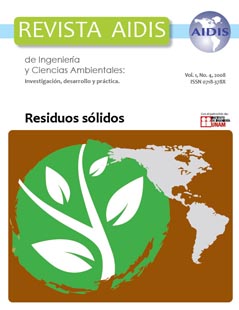Description of the behavior of earthworms population as an indicator of the quality of vermicomposting of solid organic waste
Main Article Content
Abstract
Vermicomposting technique was applied in an experimental manner to select raw materials and control parameters that allow its improvement and adoption as a solid waste treatment technique. The research was conducted by the application of the process on identical beds filled with different substrates. The substrates used were obtained from different mixture ratios of the organic fraction of urban solid wastes, organic compounds of urban solid wastes, sawdust, straw and cattle manure. The materials were analyzed for their grain size and nutritional and microbiological characteristics, before and after being subject to the vermicomposting process. The vermicomposting process of the mixtures used behaved partly as an earthworm cultivation process, partly as a composting process. In relation to vermicomposting, the most variable parameters among the beds were the quantity of green cocoons and the percentage of adult individuals, which represented two extremes of the evolution cycle of these organisms and, due to this reason, the high coefficients of variation associated with their values reflect the fact that the earthworm population in each bed was, during their harvest, in a very specific moment of their reproduction cycle, entirely or partly adapted to the substrate in which they were applied. It is worth mentioning that the highest coefficient of variation was the one associated with the quantity of green cocoons, whose presence indicated the start of a new reproduction cycle. The ratio number of youngsters:number of adults that reflects the structure of the population, varies according to the season and the earthworm species, factors that remained constant in all beds during the whole experiment and, therefore, the variation noticed should reflect the environmental differences existing among the beds. After determinations of pH, weighting and distribution of earthworms per age group it was found that the higher the pH, the higher the ratio number of youngsters:number of adults, which shows that vermicomposting may be managed by the interpretation of the variation of control parameters values normally used in both mentioned processes.
